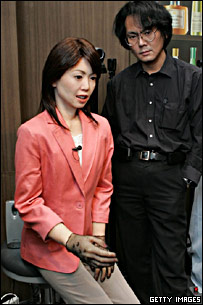|
By David Whitehouse
Science editor, BBC News website
|


Professor Ishiguro (r) stresses the importance of appearance in his robots
|
Japanese scientists have unveiled the most human-looking robot yet - a "female" android named Repliee Q1Expo. She has flexible silicone for skin rather than hard plastic, and a number of sensors and motors to allow her to turn and react in a human-like manner.
She can flutter her eyelids and move her hands like a human. She even appears to breathe.
Professor Hiroshi Ishiguro of Osaka University says one day robots could fool us into believing they are human.
Repliee Q1Expo is not like any robot you will have seen before, at least outside of science-fiction movies.
She is designed to look human and although she can only sit at present, she has 42 actuators in her upper body, powered by a nearby air compressor, programmed to allow her to move like a human.
 |
 We have found that people forget she is an android while interacting with her We have found that people forget she is an android while interacting with her 
|
"I have developed many robots before," Repliee Q1Expo's designer, Professor Ishiguro, told the BBC News website, "but I soon realised the importance of its appearance. A human-like appearance gives a robot a strong feeling of presence." Designed to look human
Before Repliee Q1Expo, Professor Ishiguro developed Repliee R1 which had the appearance of a five-year-old Japanese girl.
Its head could move in nine directions and it could gesture with its arm. Four high-sensitivity tactile sensors were placed under the skin of its left arm that made the android react differently to differing pressures.

Scientists think that, one day, robots could fool us into believing they were human
|
The follow-up has the appearance of a Japanese woman. To program her motion, a computer analysed the motions of a human and used them as a template for the way Repliee Q1Expo moves. She can be designed to follow the movement of a human wearing motion sensors or to act independently.
"Repliee Q1Expo can interact with people. It can respond to people touching it. It's very satisfying, although we obviously have a long way to go yet."
Professor Ishiguro believes that it may prove possible to build an android that could pass for a human, if only for a brief period.
"An android could get away with it for a short time, 5-10 seconds. However, if we carefully select the situation, we could extend that, to perhaps 10 minutes," he said.
"More importantly, we have found that people forget she is an android while interacting with her. Consciously, it is easy to see that she is an android, but unconsciously, we react to the android as if she were a woman."
